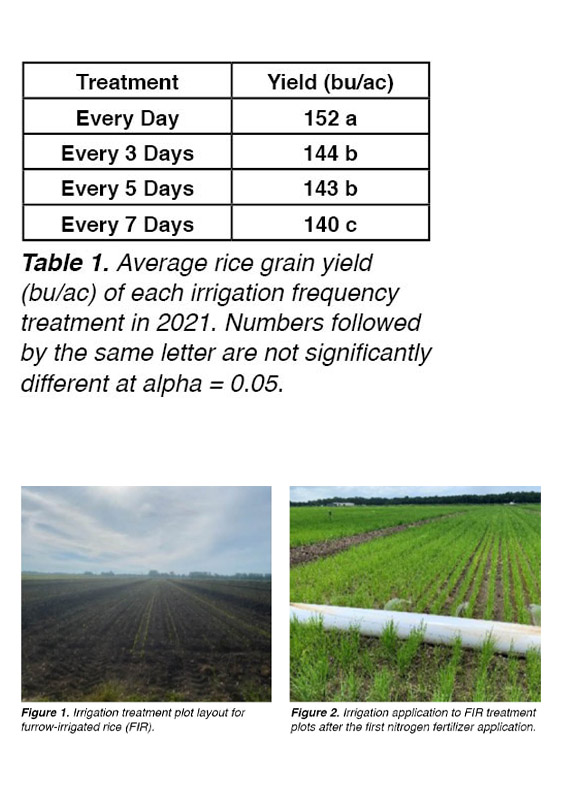Research Project
Evaluation of Irrigation Frequency to Close the Gap in Furrow Irrigated Rice
Investigators: Anna Smyly, Drew Gholson
Funding Agency: Mississippi Rice Promotion Board
Date: 2021
Project Summary
Introduction
Rice (Oryza sativa L.), in Mississippi, is typically grown using a continuous flood production system that requires large inputs of water throughout the growing season. On average, rice uses approximately 3.0 acre-feet per year of water, which, based on average acreage of rice production, equates to approximately 600,000 acre-feet per year being pumped in Mississippi. The Mississippi River Valley Alluvial Aquifer (MRVAA) serves as the major source of irrigation water for rice production in Mississippi. Irrigation water is becoming a scarce resource and the MRVAA is depleting at a rate of 300,000 acre-feet per year. Determining a more efficient approach for rice irrigation is vital to the sustainability of the aquifer for agricultural water needs. Research in Mississippi shows furrow- irrigated rice (FIR) to be a promising strategy to produce rice with less water than the regional average. However, there is limited information on how to irrigate and fertilize FIR in the most efficient way to maintain an adequate and uniform rice grain yield throughout a rice field. The objective of this study is to evaluate the effect of four different irrigation frequencies on soil moisture, irrigation water use efficiency (IWUE), water depth levels, and rice grain yield of FIR. The data for this study is collected using Watermark® soil moisture sensors, Pani- Pipes®, and flowmeters. The hypothesis is that more frequent irrigation timings in FIR will lead to an increase in rice grain yield and close the rice grain yield gap between the top and bottom one-thirds of the rice field.
Materials and Methods
A field experiment was conducted at the Delta Research and Extension Center in Stoneville, MS on a Sharkey clay soil during 2021 and will continue in 2022 and 2023. The study is designed as a randomized complete block, including four irrigation frequencies on a calendar- based schedule of irrigating every day, every three days, every five days, and every seven days. To collect soil moisture data between each irrigation occurrence, Watermark ® soil moisture sensors ® were placed at 4”, 8”, and 12” depths below the soil surface in the top one-third of each irrigation treatment and replication. To measure the water depth levels prior to each irrigation event, a Pani-Pipe® was placed in the most representative zone in the top, middle, and bottom one-thirds of each irrigation treatment and replication. A flowmeter was used to determine water usage of each irrigation treatment throughout the growing season. CL116 was planted onto freshly pulled beds at 65 lb/ac on May 24th. Each treatment plot was 8 rows wide with a levee constructed on either side of the rice plot to keep irrigation frequency treatments separated (Figure 1). Pre-emergent and post-emergent herbicides were broadcasted at the labeled rates across each rice plot after planting. Nitrogen fertilizer applications were aerially applied using a threeway split nitrogen fertilizer application recommended by the Arkansas Furrow-Irrigated Rice Production Handbook. Calendar-based irrigations began at the 4- to 5-leaf growth stage after the first nitrogen fertilizer application. Irrigations continued until the field was drained and prepared for harvest (Figure 2). Rice grain yield data was taken from the middle four rows of each plot and analyzed using statistical analysis software SAS.
Results and Discussion
The treatment plots irrigated every day resulted in the highest rice grain yield (152 bu/ ac), followed by every three days (144 bu/ac), every five days (143 bu/ac), and every seven days (140 bu/ac) (Table 1). The treatment plots irrigated every day closely mimic a continuous flood production system, which could explain why watering FIR every day produced a higher rice grain yield. The rice grain yield for the every-day treatment was significantly different when compared to the other irrigation frequencies (Table 1). Every three days and every five days were not significantly different from one another; however, both were significantly different from the other irrigation treatments. This suggests FIR grain yield will not differ greatly when a farmer is deciding on whether to irrigate every three or five days. However, when irrigating every seven days, the rice grain yield was significantly different from the other three irrigation frequencies.
Conclusion
The 2021 study suggests that irrigating FIR every day will produce a higher rice grain yield compared to irrigating every three, five, or seven days. The study also suggests that a farmer won’t see significant differences in the rice grain yield when deciding whether to irrigate every three or five days. Furrow-irrigated rice will not reach the maximum rice grain yield when the rice is irrigated every seven days. Rice is a semi-aquatic plant and prefers to be grown in a saturated environment. Therefore, when a rice plant goes seven days without being watered, the rice becomes heavily unsaturated and that affects the growth and development of the rice plant. The Watermark® soil moisture sensors®, Pani-Pipe®, and flowmeter data is still being analyzed. This study will be revised and continued for 2022 and 2023.
Project Photos

- Crop Type:
- Rice
- Topic:
- Irrigation Scheduling
- Technologies
- Irrigation
Find Research
By Crop Type
By Topic
Contact NCAAR
General Information
Kaye Sullivan
vfs23@msstate.edu
662.390.8510
F:662.390.8501
Showcase Demo
Drew Gholson, Coordinator
drew.gholson@msstate.edu
662.390.8505
Himmy Lo
himmy.lo@msstate.edu
662.390.8509

